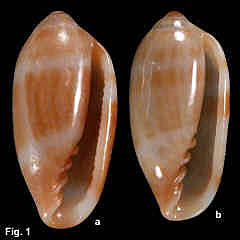|
|
|
|
|
Serrata mustelina (Angas, 1871) Diagnosis: Shell medium in size, colourless transparent or opaque white, with three to five brown bands, these narrow to broad, continuous or interrupted; spire low; lip thickened internally, varying from smooth to denticulate along its whole length; external varix present; lacking a siphonal notch; lacking parietal callus deposits and ridge; columella with four strong plaits and rarely a weak fifth, occupying less than half the aperture length. Size: Up to 8 mm in length. Distribution: Australian
Museum Collection: Comparison: There
are several similar species (eg, Serrata
agatha Laseron, 1948) recorded from Synonymy: Marginella pellucida Tenison-Woods, 1879; Marginella stanislas Tenison-Woods, 1877 (Hewish in Wilson, 1994) Remarks: The animal of this species is illustrated by Ponder (1970). He describes it as white with a very large foot indented in front. There is no operculum, and delicate, smooth mantle edges cover the shell when in the dark, quickly retracting when light falls on the animal. There are long, slender tentacles with a large eye a little above the base, and a short siphon. Fig. 1a: Broulee, NSW, beach (C.314374) Fig. 1b: Twofold Bay, NSW, 9-27 m (C.314411) |
